Aphelandra is a genus of about 170 species of flowering plants in the family Acanthaceae, native to tropical regions of the Americas. They are evergreen shrubs growing to 1–2 m tall, with opposite, simple leaves 5–30 cm long, often with white veins. The flowers are produced in dense spikes, with brightly coloured bracts. Several species are grown as houseplants for their patterned leaves and brightly coloured inflorescences.
Aphelandra Tridentata Care
Aphelandra Tridentata



How to Care for the Plant

Water

Water frequently to prevent the soil from drying out; the ground should always be a little damp.

Pruning

Prune the flower spike when it wilts so that new shoots appear.

Fertilizer

Fertilize in summer every 2 weeks with mineral fertilizer for indoor plants.

Sunlight

Zebra plants thrive in indirect light or partial shade, as they're used to growing under a canopy of trees in the tropical jungles. Direct sunlight can cause the leaves to scorch and should be avoided, but complete shade can mean that your plant won't bloom.

Soil

A Zebra plant will grow best in soil that is neutral to acidic. A multi-purpose potting blend is adequate for a Zebra plant—you can also incorporate sand into the mixture to ensure that it drains well. If a flowering plant is your goal, feed using fertilizer every one to two weeks during its growing season (spring and summer).

Temperature

Because of their tropical origins, Zebra plants grow best in moderate temperatures—their grow location should reach at least 60 degrees Fahrenheit or higher, and never dip below 55 degrees Fahrenheit. Humidity is also important to the Zebra plant, so its space should be kept at 60 to 70 percent humidity. If these conditions cannot be achieved naturally indoors, you can increase moisture levels by using a humidifier. Overall, strive to maintain an even temperature for your plant, avoiding high fluctuations in either direction and keeping it away from any vents that could make it too hot or too cold (such as an air conditioner).

Container

Any propagated Zebra plants should be repotted once the plant grows roots and reaches maturity. Beyond that, Zebra plants do not need to be repotted often, benefitting from a new home only every two to three years.

Additional

Zebra plant is considered non-toxic, however, it can irritate skin. When pruning, it's best to wear gloves to avoid coming in contact with the plant's sap.

Popularity

56 people already have this plant 8 people have added this plant to their wishlists
Discover more plants with the list below
Popular articles






